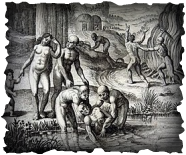
Killed 75 million people worldwide.
The Black Death, or The Black Plague, was one of the most deadly pandemics in human history. It began in South-western or Central Asia and spread to Europe by the late 1340s. The total number of deaths worldwide from the pandemic is estimated at 75 million people; there were an estimated 20 million deaths in Europe alone. The Black Death is estimated to have killed between a third and two-thirds of Europe's population.
The Black Death, or The Black Plague, was one of the most deadly pandemics in human history. It began in South-western or Central Asia and spread to Europe by the late 1340s. The total number of deaths worldwide from the pandemic is estimated at 75 million people; there were an estimated 20 million deaths in Europe alone. The Black Death is estimated to have killed between a third and two-thirds of Europe's population.
The three forms of plague brought an array of signs and symptoms to those infected. Bubonic plague refers to the painful lymph node swellings called buboes, mostly found around the base of the neck, and in the armpits and groin. The septicaemic plague is a form of blood poisoning, and pneumonic plague is an airborne plague that attacks the lungs before the rest of the body. The classic sign of bubonic plague was the appearance of buboes in the groin, the neck and armpits, which oozed pus and bled. Victims underwent damage to the skin and underlying tissue, until they were covered in dark blotches. Most victims died within four to seven days after infection. When the plague reached Europe, it first struck port cities and then followed the trade routes, both by sea and land. The bubonic plague was the most commonly seen form during the Black Death, with a mortality rate of thirty to seventy-five percent and symptoms including fever of 38 - 41 °C (101-105 °F), headaches, painful aching joints, nausea and vomiting, and a general feeling of malaise. Of those who contracted the bubonic plague, 4 out of 5 died within eight days. Pneumonic plague was the second most commonly seen form during the Black Death, with a mortality rate of ninety to ninety-five percent.
The same disease is thought to have returned to Europe every generation with varying virulence and mortalities until the 1700s. During this period, more than 100 plague epidemics swept across Europe. On its return in 1603, the plague killed 38,000 Londoners. Other notable 17th century outbreaks were the Italian Plague of 1629-1631, the Great Plague of Seville (1647-1652), the Great Plague of London (1665–1666), the Great Plague of Vienna (1679). There is some controversy over the identity of the disease, but in its virulent form, after the Great Plague of Marseille in 1720–1722 and the 1771 plague in Moscow it seems to have disappeared from Europe in the 18th century. The fourteenth-century eruption of the Black Death had a drastic effect on Europe's population, irrevocably changing Europe's social structure. It was a serious blow to the Roman Catholic Church and resulted in widespread persecution of minorities such as Jews, foreigners, beggars and lepers. The uncertainty of daily survival created a general mood of morbidity influencing people to "live for the moment", as illustrated by Giovanni Boccaccio in The Decameron (1353).

 RSS Feed
RSS Feed